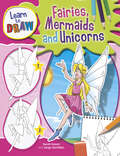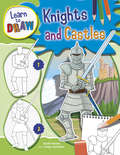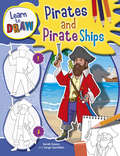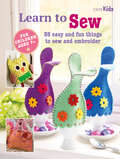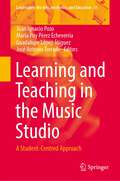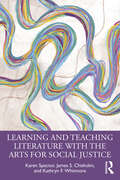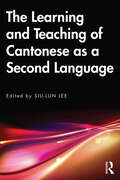- Table View
- List View
Learn to Draw Fairies, Mermaids and Unicorns: Fairies Mermaids And Unicorns (Learn to Draw #4)
by Jorge SantillanLearn to Draw: Fairies shows children how to draw six incredible mythical creatures, from forest, water and fire fairies to mermaids and unicorns. Each drawing is broken down into seven simple, easy-to-follow steps to help children create, and then colour in, their own mythical creature pictures. Fact boxes on each spread provide information about each creature, allowing children to learn about, as well as to draw, them. A glossary at the back of the book explains any complicated words, and a 'More Information' section gives suggestions as to how children can find out more about myths and legends.If children have loved learning to draw mythical creatures, why not try learning to draw dinosaurs, dragons, baby animals, knights, castles, pirates and pirate ships in other titles in the series?
Learn to Draw in a Weekend
by Richard TaylorPerfect for the aspiring artist! Covers basic techniques and guides reader to finished projectsIncludes an array of inspirational artworkCompetitive pricing, authoritative advice and a popular subject make this title a must-have for aspiring artists. Perfect for beginners and leisure artists, this book guides the reader from the most basic shapes and objects through to fully developed and varied projects. Readers will find encouraging advice and instruction for a variety of drawing media, including graphite pencils, colored pencil, Conte, pastel, charcoal and more.
Learn to Draw: Knights and Castles (PDF)
by Jorge SantillanLearn to Draw: Knights and Castles shows children how to draw six medieval things, from knights on horseback and coats of arms to fortified castles and fortresses. Each drawing is broken down into seven simple, easy-to-follow steps to help children create, and then colour in, their own knight and castle pictures. Fact boxes on each spread provide information about knights and castles, allowing children to learn about, as well as to draw, them. A glossary at the back of the book explains any complicated words, and a 'More Information' section gives suggestions as to how children can find out more about knights and castles.
Learn to Draw Pirates: Pirates (Learn to Draw #3)
by Jorge SantillanLearn to Draw: Pirates shows children how to draw six piratical things, from pirate captains and peg-leg sailors to enormous pirate sailing ships. Each drawing is broken down into seven simple, easy-to-follow steps to help children create, and then colour in, their own pirate pictures. Fact boxes on each spread provide information about pirates, allowing children to learn about, as well as to draw, them. A glossary at the back of the book explains any complicated words, and a 'More Information' section gives suggestions as to how children can find out more about pirates.If children have loved learning to draw pirates, why not try learning to draw dinosaurs, dragons, fairies, mermaids, unicorns, knights, castles, baby animals in other titles in the series?
Learn to Knit
by Clare DaviesLearn to knit with me Clare Davies - knitting teacher at The Gilliangladrag Fluff-a-torium. I like to think I’m a patient knitting and crochet teacher and I hope this lesson from me in the studio, to you in the comfort of your home (or wherever you fancy knitting) will be an easy to follow and enjoyable experience. In this beautifully illustrated little book, I will share with you the basics to get you started, and then move you on to some simple projects to practice what you’ve learnt. Find out what equipment you’ll need, learn different knitting stitches and how to make a scarf! Then I will talk you through finishing techniques and some great tips for the future. You’ll be knitting in no time!
Learn to Needle-Felt
by Mia UnderwoodChildren will discover the fun of needle-felting with these 30 adorable step-by-step animal projects. With this fabulous My First book children aged 7+ can create a wonderful menagerie of adorable needle-felted animals. The projects will appeal to all young crafters, and are wonderful for children to keep for themselves or give as gifts. Craft expert Mia Underwood begins with 2D projects, such as brooches and a bookmark, then moves on to simple 3D projects such as a cute hamster and a wide-eyed owl. Children can then progress their needle-felting skills by making dogs, a squirrel, a panda, a pony, and many more fantastic creatures. There is a comprehensive techniques section so that children can perfect their needle-felting skills, and each project includes an adorable photo of the finished animal and is broken down into clear illustrated steps.
Learn to Paint People Quickly: A Practical, Step-by-step Guide To Learning To Paint People In Watercolour And Oils (Learn Quickly Ser. #04)
by Hazel SoanLearn to Program with Kotlin: From the Basics to Projects with Text and Image Processing
by Tim LaversTeach yourself programming starting with the basics and progressing to a series of exciting projects using Kotlin, one of today's hottest programming languages. This book starts with the absolute basics and then introduces just enough syntax to get into some fascinating projects. These include text processing: a statistical analysis of Jane Austen's novels, solving anagrams, and working with palindromes; image processing: cropping and resizing images, and pixel transformation; and computer vision: finding digits, parsing images, and reading speed signs. The projects are developed in tiny steps and complete solutions are provided. Some of these projects include core data science concepts, giving you skills in one of the most important areas of modern programming. Along the way you’ll cover functional programming, object-oriented programming (OOP), refactoring, and writing unit tests. After reading Learn to Program with Kotlin, you'll come away with practical insights and code to get you started right away with programming using Kotlin for your own projects. What You Will Learn Gain the basics of Kotlin using the IntelliJ Java IDE Implement OOP with Kotlin along with unit testing and code refactoring using a series of text-related projects Harness functional programming with Kotlin by building an image-processing library Write software to locate and read speed signs in photos Who Is This Book For Anyone who wants to learn how to program or code from scratch. Also great for experienced programmers who want to know more about Kotlin.
Learn to Sew
by CICO BooksLearn how to sew as you make fabulous toys, gifts, cards, bags and many more items you will be proud of! These 35 brilliant sewing projects have been specially designed for children aged 7 and upwards. In the Terrific Toys chapter, you’ll find juggling animals, sock monsters and rag dolls, while in Fashion Fun, there are gorgeous bags, hair accessories and more. Next, discover some Delightful Decorations – from hanging felt stars to pretty lavender bags. Finally, Gifts and Cards is packed with ideas, such as the finger puppet cards, felt egg cosies or the sausage dog draft excluder. The sewing techniques explain every stitch you’ll need and all the instructions and cute step-by-step artworks are easy to follow. Plus, each project has a grade so that you can start with easy sewing and move on to using more advanced stitches as you get better at it.
Learn to Sew
by Fiona HesfordLearn to sew with me Fiona Hesford - sewing teacher at The Gilliangladrag Fluff-a-torium. I like to think I’m a patient and understanding sewing teacher and I hope my years of experience will help to guide you through the art of sewing, whilst not only being easy to follow, but also an enjoyable experience. In this beautifully illustrated little book, I will share with you the basics to get you started, and then move you on to some simple projects to practice what you’ve learnt. Find out what equipment you’ll need, learn some great tips and follow my simple guides to making beautiful creations, including an elasticated skirt, lined tote bag and a patchwork cushion. Master the art of sewing in no time
Learn to Sew and Embroider
by Emma HardySewing is fun – learn how to do it yourself with this step-by-step guide. Pick up this book and you'll soon be a sewing whiz, using a wide variety of hand stitches and learning how to sew on a zip, attach buttons, embroider, and appliqué. In Jewellery and Accessories, you can make adorable watermelon slice brooches or a fun raccoon scarf, while Toys and Dolls features a fake fur teddy bear that would make a great gift – he's so sweet, though, that you might want to keep him for yourself! Next is Stationery and Storage, which makes being organised fun – you'll be the star of your class with the monster pencil case and the customised tote bag to carry your books in. Finally, in Gift Ideas, you can learn some beautiful embroidery stitches with the monogrammed pillowcase, or surprise a friend for their birthday with some personalised bunting. All of the projects have simple step-by-step artworks to guide you, plus a clearly marked skill level so that you can start with the easier projects and move on to more challenging crafts as you become a more confident stitcher.
Learn to Timber Frame: Craftsmanship, Simplicity, Timeless Beauty
by Will BeemerThe elegant simplicity of timber frame construction is made accessible to all levels of builders with step-by-step building instructions for one small, easy-to-build timber frame cabin, along with plans for modifying it to suit particular needs and locations.
Learn Watercolour Quickly: Techniques And Painting Secrets For The Absolute Beginner (Learn Quickly Ser. #01)
by Hazel SoanThe Learned Collector: Mythological Statuettes and Classical Taste in Late Antique Gaul
by Lea StirlingInspired by a classical education, wealthy Romans populated the glittering interiors of their villas and homes with marble statuettes of ancestors, emperors, gods, and mythological figures. In The Learned Collector, Lea M. Stirling shows how the literary education received by all aristocrats, pagan and Christian alike, was fundamental in shaping their artistic taste while demonstrating how that taste was considered an important marker of status. Surveying collections across the empire, Stirling examines different ways that sculptural collections expressed not only the wealth but the identity of their aristocratic owners. The majority of statues in late antique homes were heirlooms and antiques. Mythological statuary, which would be interpreted in varying degrees of complexity, favored themes reflecting aristocratic pastimes such as dining and hunting. The Learned Collector investigates the manufacture of these distinctive statuettes in the later fourth century, the reasons for their popularity, and their modes of display in Gaul and the empire. Although the destruction of ancient artwork looms large in the common view of late antiquity, statuary of mythological figures continued to be displayed and manufactured into the early fifth century. Stirling surveys the sculptural decor of late antique villas across the empire to reveal the universal and regional trends in the late antique confluence of literary education, mythological references, aristocratic mores, and classicizing taste. Deftly combining art historical, archaeological, and literary evidence, this book will be important to classicists and art historians alike. Stirling's accessible writing style makes this an important work for scholars, students, and anyone with an interest in Roman statues of this era. Lea M. Stirling is Associate Professor of Classics at the University of Manitoba and holds a Canada Research Council Chair in Roman Archaeology. She co-directs excavations at the ancient city of Leptiminus, Tunisia.
Learning and Collaboration Technologies. Designing Learning Experiences: 6th International Conference, LCT 2019, Held as Part of the 21st HCI International Conference, HCII 2019, Orlando, FL, USA, July 26–31, 2019, Proceedings, Part I (Lecture Notes in Computer Science #11590)
by Panayiotis Zaphiris Andri IoannouThis two-volume set LNCS 11590 and 11591 constitutes the refereed proceedings of the 6th International Conference on Learning and Collaboration Technologies, LCT 2019, held as part of the 21st International Conference on Human-Computer Interaction, HCII 2019, in Orlando, FL, USA in July 2019. The 1274 full papers and 209 posters presented at the HCII 2019 conferences were carefully reviewed and selected from 5029 submissions. The papers cover the entire field of human-computer interaction, addressing major advances in knowledge and effective use of computers in a variety of applications areas. The papers in this volume are organized in the following topical sections: designing and evaluating learning experiences; theoretical and pedagogical approaches in technology-enhanced learning; cognitive and psychological issues in learning; and technology in STEM education.
Learning and Collaboration Technologies. Ubiquitous and Virtual Environments for Learning and Collaboration: 6th International Conference, LCT 2019, Held as Part of the 21st HCI International Conference, HCII 2019, Orlando, FL, USA, July 26–31, 2019, Proceedings, Part II (Lecture Notes in Computer Science #11591)
by Panayiotis Zaphiris Andri IoannouThis two-volume set LNCS 11590 and 11591 constitutes the refereed proceedings of the 6th International Conference on Learning and Collaboration Technologies, LCT 2019, held as part of the 21st International Conference on Human-Computer Interaction, HCII 2019, in Orlando, FL, USA in July 2019. The 1274 full papers 209 posters presented at the HCII 2019 conferences were carefully reviewed and selected from 5029 submissions. The papers cover the entire field of human-computer interaction, addressing major advances in knowledge and effective use of computers in a variety of applications areas. The papers in this volume are organized in the following topical sections: mobile and ubiquitous learning; virtual reality and augmented reality systems for learning; and collaborative technology.
Learning and Teaching in the Music Studio: A Student-Centred Approach (Landscapes: the Arts, Aesthetics, and Education #31)
by Juan Ignacio Pozo María Puy Pérez Echeverría Guadalupe López-Íñiguez José Antonio TorradoThis book advocates for a radical change in music teaching and learning methods, allowing for a break from the traditional conservatory model still in use in many classrooms. The product of twenty years of interdisciplinary work by musicians, music teachers, and psychologists, the book proposes to place the focus of music education on the students themselves and on their mental and physical activity, with the aim of helping them to manage their own goals and emotions. This alternative is based on a new theoretical framework, as well as numerous real, concrete examples of how to put it into practice with students of different ages and in different environments. This book focuses primarily on teaching instrumental music, but its content will be useful for any teacher, student, musician, or researcher interested in improving music education in any environment, whether formal or informal, in which it takes placeChapters 3, 4, 6 and 18 are available open access under a Creative Commons Attribution 4.0 International License via link.springer.com.
Learning and Teaching Literature with the Arts for Social Justice
by Karen Spector James S. Chisholm Kathryn F. WhitmoreThis text invites pre-service teachers to explore arts-informed practices that showcase the transformative potential of literature in the classroom. Through the lens of "stories-we-live-by," the authors recognize literature as interference, capable of disrupting the habitual patterns through which we interpret the world in order to reawaken the capacity of students and teachers alike to change. Chapters are designed to inspire students’ love of literature by fostering literary and artful encounters that provoke their thinking and sense-making. Each chapter includes engaging pedagogical features that spark thinking and analysis of literature and invite readers to further engagement. The appendices include directions for instruction as well as additional resources. An essential text for courses on children’s and adolescent literature and English methods, pre-service teachers will come away with plenty of text recommendations and arts- and social justice-informed practices to use with their future students. Through artful encounters with visual learning analyses, visual-verbal journals, drama, soundscapes, poetry, and so much more, readers examine their own transformative experiences with literature. Readers will learn to craft and curate practices that encourage engagement, imagination, experimentation, and self-awareness in and beyond the classroom.
Learning and Teaching Literature with the Arts for Social Justice
by Karen Spector James S. Chisholm Kathryn F. WhitmoreThis text invites pre-service teachers to explore arts-informed practices that showcase the transformative potential of literature in the classroom. Through the lens of "stories-we-live-by," the authors recognize literature as interference, capable of disrupting the habitual patterns through which we interpret the world in order to reawaken the capacity of students and teachers alike to change. Chapters are designed to inspire students’ love of literature by fostering literary and artful encounters that provoke their thinking and sense-making. Each chapter includes engaging pedagogical features that spark thinking and analysis of literature and invite readers to further engagement. The appendices include directions for instruction as well as additional resources. An essential text for courses on children’s and adolescent literature and English methods, pre-service teachers will come away with plenty of text recommendations and arts- and social justice-informed practices to use with their future students. Through artful encounters with visual learning analyses, visual-verbal journals, drama, soundscapes, poetry, and so much more, readers examine their own transformative experiences with literature. Readers will learn to craft and curate practices that encourage engagement, imagination, experimentation, and self-awareness in and beyond the classroom.
The Learning and Teaching of Cantonese as a Second Language
by Siu-Lun LeeThe Learning and Teaching of Cantonese as a Second Language brings together contributions on such issues as Cantonese textbooks, linguistic description, literacy and tone acquisition, supplemented by case studies from the Netherlands and Japan. The learning and teaching of Cantonese as a second language is a subject of considerable interest in the international academic community, and the first international symposium on teaching Cantonese as a second language, held at the Chinese University of Hong Kong in October 2019, brought together leading researchers in this field. This conference provided the inspiration for the current volume, The Learning and Teaching of Cantonese as a Second Language. In the Hong Kong context, historically, the term ‘Cantonese’ refers to the language varieties of immigrants who came to the territory from various areas in Guangdong province, including Macau, Panyu, Taishan, Xinhui and Zhongshan. From the late nineteenth century onwards, their speech coalesced into the contemporary variety of Cantonese used in Hong Kong today. The term ‘Cantonese’ is also used to refer to the entire Yue subgroup of Chinese, which includes varieties of Cantonese spoken in southern China, Hong Kong, Macau, Malaysia, Singapore and among overseas Chinese in Australia, Europe and North America. In all, it is estimated that there are about 70 million Cantonese speakers in the world. This volume is of direct relevance to educators, language teachers, linguists and all those concerned with the learning of Cantonese as a second language.
The Learning and Teaching of Cantonese as a Second Language
The Learning and Teaching of Cantonese as a Second Language brings together contributions on such issues as Cantonese textbooks, linguistic description, literacy and tone acquisition, supplemented by case studies from the Netherlands and Japan. The learning and teaching of Cantonese as a second language is a subject of considerable interest in the international academic community, and the first international symposium on teaching Cantonese as a second language, held at the Chinese University of Hong Kong in October 2019, brought together leading researchers in this field. This conference provided the inspiration for the current volume, The Learning and Teaching of Cantonese as a Second Language. In the Hong Kong context, historically, the term ‘Cantonese’ refers to the language varieties of immigrants who came to the territory from various areas in Guangdong province, including Macau, Panyu, Taishan, Xinhui and Zhongshan. From the late nineteenth century onwards, their speech coalesced into the contemporary variety of Cantonese used in Hong Kong today. The term ‘Cantonese’ is also used to refer to the entire Yue subgroup of Chinese, which includes varieties of Cantonese spoken in southern China, Hong Kong, Macau, Malaysia, Singapore and among overseas Chinese in Australia, Europe and North America. In all, it is estimated that there are about 70 million Cantonese speakers in the world. This volume is of direct relevance to educators, language teachers, linguists and all those concerned with the learning of Cantonese as a second language.
Learning AndEngine
by Martin VargaIf you are a beginner to AndEngine, or mobile game development in general, and you are looking for a simple way to start making games for Android, this book is for you. You should already know the basics of Java programming, but no previous game development experience is required.
Learning Android Game Development
by Nikhil MalankarLearn the art of making Android games and turn your game development dreams into reality About This Book • Leverage the latest features of Android N to create real-world 2D games • Architect a 2D game from scratch and level up your Android game development skill • Transition from developing simple 2D games to 3D games using basic Java code Who This Book Is For If you are a mobile developer who has basic Java programming knowledge, then this book is ideal for you. Previous Android development experience is not needed; however, basic mobile development knowledge is essential. What You Will Learn • Understand the nuts and bolts of developing highly interactive and interesting games for Android N • Link the interface to the code used in games through simple methods • Interact with the images on the screen and also learn to animate them • Set and save the game state and save high scores, hit points, and so on for your games • Get a grasp of various collision techniques and implement the bounding box technique • Convert your 2D games to 3D games using Android N • Get an understanding of the process of UI creation using Android Studio In Detail In this book, we'll start with installing Android studio and its components, and setting it up ready for Android N. We teach you how to take inputs from users, create images and interact with them, and work with sprites to create animations. You'll then explore the various collision detection methods and use sprites to create an explosion. Moving on, you'll go through the process of UI creation and see how to create buttons as well as display the score and other parameters on screen. By the end of the book, you will have a working example and an understanding of a 2D platform game like Super Mario and know how to convert your 2D games to 3D games. Style and approach This easy-to-understand guide follows a step-by-step approach to building games, and contains plenty of graphical examples for you to follow and grasp quickly, giving you the chance to implement the concepts practically.
